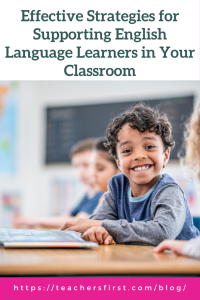Rita Mae Brown’s quote demonstrates how learning a new language for English language learners (ELLs) is not just about communication but also about gaining insight into a new culture and way of life. Currently, ELLs are a growing population in U.S. public schools, with an average of 10 percent of students classified as ELLs nationwide and up to 19 percent in large states such as Texas (National Center for Education Statistics, 2022). Teachers are tasked with taking on this major responsibility to provide meaningful support to ELLs to help them succeed, regardless of their English proficiency level. This blog post will explore practical strategies and techniques that can help you effectively support ELLs in your classroom. Whether you are an experienced teacher or just starting your teaching career, this post will provide valuable insights and actionable steps to help you better support your ELL students!
“Wordless Books”
The first strategy I’m going to share has been popular for many years. The “Wordless Book” is a tool typically used for emerging readers but can also help ELLs build essential literacy skills, listening skills, and vocabulary. Sharing wordless books provides an opportunity for literacy-rich conversations without feeling overwhelmed by unfamiliar vocabulary. Students can create their own story in their own words. In addition, Wordless Books can create a more inclusive classroom! Many wordless books are available, but if you need help figuring out where to start, consider checking out Epic! (reviewed here), a digital library that is free for educators. Epic! provides access to a wide variety of wordless books and other reading materials. To make the most of this strategy, consider some of these seven tips for sharing wordless books from ¡Colorín Colorado!
Six-Word Summaries
The next strategy is the six-word summary. Six-word summaries can be a valuable tool for ELLs because they offer a concise way to summarize information without worrying about vocabulary or complex grammar. Additionally, a six-word summary can be used in various contexts, such as in reading assignments, discussions, and assessments, making it a versatile and practical tool for ELLs to use in their language learning journey! Finally, once students have written their six-word summary, you can use a simple digital bulletin board like Padlet (reviewed here) to publish it for an audience beyond the classroom.
Emojis
Over recent years Emojis have become one of the most popular forms of communication. While often seen as an informal communication tool used for texting or social media, emojis can also be a valuable resource for ELLs. Emojis can be used to help ELLs understand and communicate concepts and emotions by providing visual cues that support their learning. For example, using emojis to illustrate vocabulary words or concepts can help ELLs better comprehend and remember them. Additionally, teachers can use emojis as a fun and interactive way to assess understanding by having students use them to respond to questions or prompts. In this way, emojis can help ELLs feel more included and engaged in the classroom. For additional ideas on using emojis in the classroom, listen to this Easy EdTech podcast (or read the transcript) by Dr. Monica Burns.
Lastly, consider how you can honor and integrate ELL students’ cultural backgrounds and experiences. When the cultural backgrounds of ELLs are incorporated into the classroom environment, you’re nurturing a sense of belonging for ELLs and all students.
In conclusion, supporting English Language Learners in the classroom can be challenging but rewarding. By incorporating intentional, practical strategies like those shared in this post, teachers can provide meaningful support to ELL students and help them succeed in their language learning journey. However, there are many other strategies and techniques out there, and I invite you to share your strategies and experiences in supporting ELLs in the comments below!



